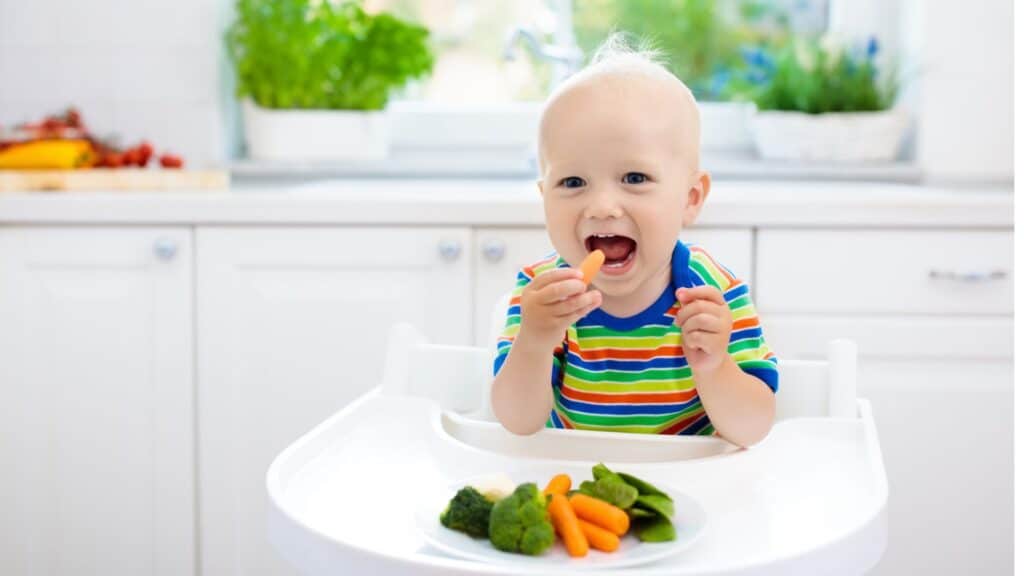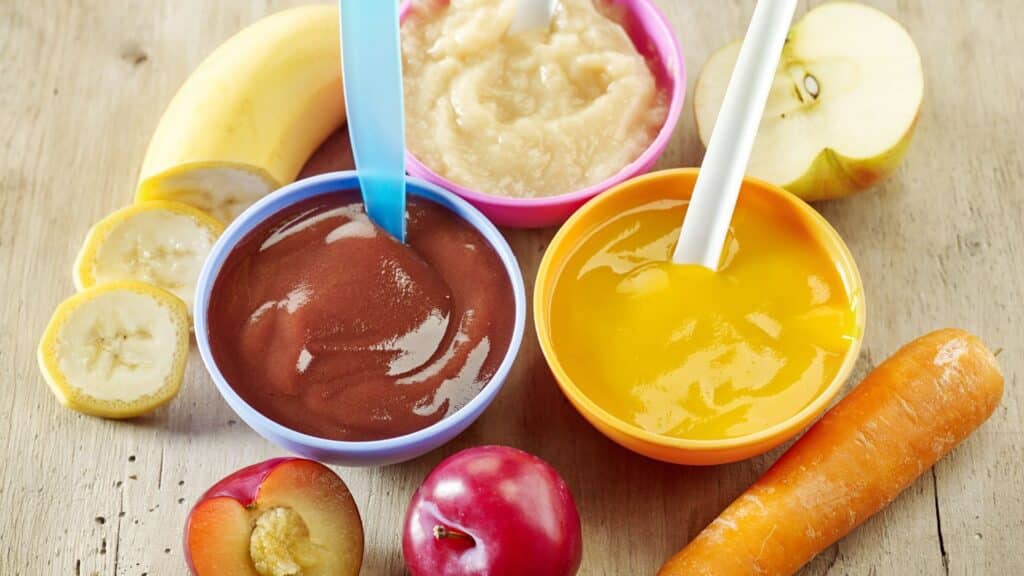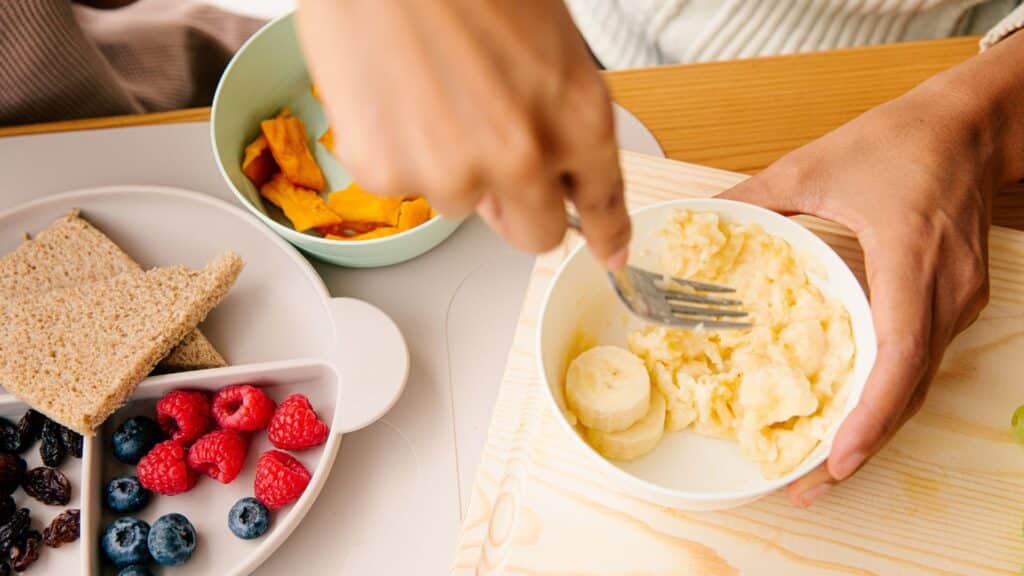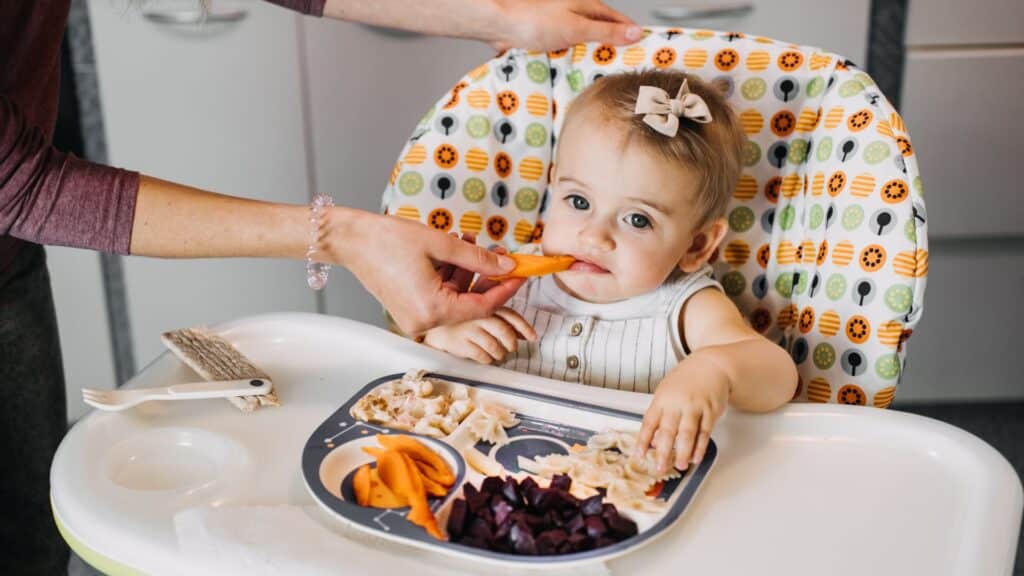Introducing solid foods to your baby is a significant milestone. It’s also one that can sometimes feel overwhelming, especially if you’re new to the whole parenting thing.
We’re here to help! We’ve put together a list of guidelines for introducing solid foods that will make the process easier and more enjoyable for both you and your baby, and we’ve made it in a way that’s fun and easy to read.

When to Introduce Solid Foods
The American Academy of Pediatrics recommends that most babies begin eating solid foods at around 6 months of age. To prevent food allergies and ensure your baby receives essential nutrients, it’s best to introduce new foods one at a time, waiting 3 or 4 days between each introduction. This way, you can watch for any signs of allergy or intolerance, such as rashes or digestive upset.
When you prepare food for your baby, be sure to choose appropriate baby foods or finger foods that are easy to eat and digest. Baby cereal is an excellent first food, fortified with iron and other nutrients. As your baby becomes more comfortable eating solids, you can introduce allergenic foods, such as eggs and nuts, one at a time and in small quantities.
It’s important to note that feeding babies solid foods too early can lead to serious illness, as their digestive systems are not yet fully developed. When introducing solids, pay close attention to how your baby’s mouth and tongue move as they learn to eat.
With patience and persistence, your baby will gradually become comfortable eating solids and enjoying new flavors and textures.

Signs of Readiness
Note that it’s important to watch for signs of readiness before starting solid foods, especially if you’re making your baby food. Some symptoms that a baby is ready for solid foods include:
- The baby can sit up well without help.
- The baby can hold his head up.
- The baby’s neck muscles are strong enough to support the head.
- The baby has good neck control. The head should be able to turn from side to side and look up and down easily.
- Your baby can swallow food without choking or gagging.
It’s a good idea to consult with your pediatrician about introducing solid foods and what foods to offer if your baby has any special dietary needs or health concerns.
Types of Solid Foods to Introduce First
The first solid foods you introduce to your baby should be those least likely to cause an allergic reaction. Here are some recommended first foods for infants:
Iron-Fortified Infant Cereal
When introducing baby solid foods, starting with iron-rich foods is essential. One of the best options is single-grain baby cereal that is iron-fortified, such as rice cereal. It helps babies to get the necessary nutrients while gradually getting used to solid foods.
While there are different types of baby cereals like oatmeal or barley, it is recommended to start with only rice cereal to avoid overwhelming your baby with unfamiliar food textures. Mixing the rice cereal with breast milk or infant formula can make swallowing the runny cereal easier for your baby.

Pureed Vegetables
Pureed vegetables are an excellent choice to introduce as a baby’s first finger food. They are naturally sweet and tasty, making it easier for babies to adjust to new flavors and textures. Cooked carrots, sweet potatoes, peas, and squash are highly nutritious and contain all the vitamins vital for the baby’s nutrition, especially iron, for building strong muscles and bones.
To prevent choking, it’s essential to steam or cook the vegetables until they are soft and tender before pureeing them with breast milk or formula. Parents can provide their little ones with a nutritious and delicious meal by incorporating pureed vegetables into the baby’s diet when starting solid foods.
Pureed Fruits
When it comes to introducing solid foods to your baby, it’s important to start with fruits, as they are easy to digest and provide essential nutrients for growth and development. However, it’s important to note that too much fruit juice can harm your baby’s health, so it’s best to avoid it and stick to pureed fruits.
Additionally, some fruits, like citrus and berries, can be potentially allergenic, so it’s a good idea to introduce them gradually and one at a time. Apples, pears, bananas, and avocados are great options to start with, as they are less likely to cause allergic reactions.
Starting with pureed fruits can help your baby develop healthy eating habits and get all the vitamins and nutrients they need to thrive.

Pureed Meat
Meat purees are suitable for a baby’s digestion and protein development. Pureed meat can be mixed with breast milk or formula, so pureed meat is an excellent way to start with solid foods.
Chicken, turkey, and beef are good choices. Cook the meat until tender, then puree it with breast milk or formula.
It’s important to introduce one new food at a time and wait a few days before introducing another new food. This can help you identify any allergies or sensitivities your baby may have. If your baby reacts to a certain food, stop feeding it to them and consult with your pediatrician.
As your baby ages, you can introduce more variety and texture to its diet. It’s important to continue offering breast milk or formula until your baby is 12 months old, as it provides important nutrients for growth and development.
Tips for Preparing Homemade Baby Food
Preparing homemade baby food is a fun and rewarding way to spend time with your little one.
It can also be a lot of work, especially if you need help figuring out what to do. Here are some tips for getting started:
Start With Fresh, High-Quality Ingredients
Choose fresh fruits and vegetables that are in season, organic, and free of pesticides and chemicals.
Start with a large stock of ripe fruits and vegetables, but not overripe. Fruits should be firm but not rock-hard or squishy. Vegetables should be bright in color and firm to the touch.

Wash and Sanitize Everything
Make sure to wash your hands regularly throughout the process, and wash all your equipment before using it. This will help ensure you’re not introducing bacteria into your baby’s food.
Cook the Food Properly
Cooking food properly is one of the most important parts of preparing homemade baby food. You want to ensure you cook the food until it’s soft and mushy enough for your baby to eat it quickly.
If you’re using fresh vegetables or fruit, steam them for 10 minutes before pureeing them with an immersion or regular blender.
Puree or Mash the Food
When introducing solid foods to your baby, it’s important to puree or mash the food to make it easier for them to eat. This can be done using a blender, food processor, or by hand. Before blending, make sure to remove any skin or seeds that could be a choking hazard.
Avoid offering your baby small, slippery foods like whole grapes, hot dogs, or hard candy, as they can pose a choking risk. It’s safer to offer fruits or meat that have been mashed or pureed to prevent choking hazards.
Add Liquid
Add breast milk, formula, or water to thin out the pureed food to a consistency easy for your baby to swallow. However, not all liquids are beneficial to your baby. It’s an off-limit to offer cow’s milk, honey, or unpasteurized food, as these don’t meet an infant’s nutritional needs.
Freeze in Small Portions
Freeze the homemade baby food in small portions, using ice cube trays or small containers. This way, you can thaw out just enough for each meal.
Label and Date
Label and date the frozen baby food to track what you have and when it was made.
Always follow safe food handling practices and consult with your pediatrician if you have concerns about your baby’s diet or feeding.

How to Introduce Solid Foods
The introduction of solid foods is a significant milestone for your baby. And while it may seem simple, there are quite a few steps you need to take before you begin.
- Choose when your baby is awake and alert but not too hungry or full.
- Sit your baby in a highchair and ensure they are comfortable and supported.
- Offer a small amount of the food on a soft-tipped spoon.
- Allow your baby to taste and explore the food. They may initially push the food out of their mouth, but this is normal.
- Offer breast milk or formula after the solid food to ensure your baby gets enough nutrition.
- Repeat the process with different foods, one at a time, and wait a few days before introducing a new food.
Start with a small amount of food, about 1 to 2 teaspoons, and gradually increase the amount over time. Offer solid foods once a day, then gradually increase to two or three times daily. Continue to offer breast milk or formula as the primary source of nutrition until your baby is at least 12 months old.
Tips for Encouraging Your Baby to Try New Foods:
- Offer a variety of foods to your baby, including fruits, vegetables, and grains.
- Encourage your baby to explore and touch the food with their hands.
- Offer the same food multiple times, as it can take up to 10 or more tries for a baby to accept a new food.
- Make mealtimes fun by sitting with your baby and offering positive reinforcement.
- Be patient, and don’t force your baby to eat if they’re uninterested. It’s important to let your baby lead the way regarding solid foods.

Common Issues and Concerns
Potential Choking Hazards and How to Avoid Them
When introducing solid foods, it’s important to be aware of potential choking hazards and take steps to avoid them. Some common choking hazards include:
- Small, hard foods like nuts, popcorn, and hard candies.
- Sticky or gooey foods like peanut butter or marshmallows.
- Large chunks of food can get stuck in the baby’s throat.
To avoid choking hazards:
- Cut foods into small, bite-sized pieces.
- Cook fruits and vegetables until they are soft and easy to mash.
- Avoid giving your baby round or hard foods, like grapes or raw carrots.
- Always supervise your baby while they are eating.
Dealing With Food Allergies and Sensitivities
Food allergies and sensitivities can develop at any time, so it’s important to be aware of the signs of an allergic reaction, which can include:
- Hives or rash
- Swelling of the face, lips, or tongue
- Difficulty breathing
- Vomiting or diarrhea
Talk to your pediatrician if you suspect your baby has a food allergy or sensitivity. They may recommend allergy testing or suggest avoiding certain foods. It’s important always to read food labels carefully and avoid foods that contain allergens your baby is allergic to.
Advice on Dealing with Picky Eaters
It’s common for babies and young children to be picky eaters, but there are steps you can take to encourage healthy eating habits:
- Offer a variety of foods and flavors, and let your baby explore and try new foods at their own pace.
- Avoid pressuring your baby to eat or using food as a reward or punishment.
- Make mealtimes fun by sitting and eating together as a family.
- Offer healthy choices, but let your baby decide what and how much to eat.
- Be patient and continue offering a variety of healthy foods, even if your baby initially refuses them.

Takeaways
In conclusion, introducing solid foods to your baby can be a fun and exciting milestone. Still, following some guidelines is important to ensure your baby gets the proper nutrients and is ready for solid foods.
Always consult your pediatrician for concerns or questions about introducing solid foods. Starting with iron-fortified infant cereal and pureed fruits and vegetables can help your baby get used to different flavors and textures.
Introducing one new food at a time can help you identify any allergies or sensitivities your baby may have.
Preparing homemade baby food is a great way to ensure your baby gets high-quality, fresh ingredients, but follow proper food safety guidelines and cooking techniques.
Remember to continue offering breast milk or formula until your baby is 12 months old, as it provides important nutrients for growth and development.
With patience, love, and guidance, introducing solid foods to your baby can be a wonderful journey for you and your little one.
Please let us know if you have any questions. We’d be happy to answer them.



